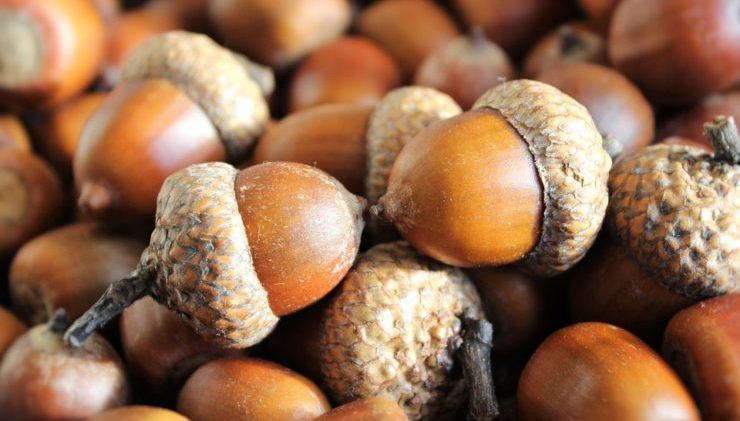
Editor’s note: We’re looking at the never-ending debate over what is called, in journalese, the “nut graf” — that so-what paragraph or section that pulls out of the news or narrative to provide context and significance. In earlier posts, veteran writer and story coach Chip Scanlan weighed in with a strong caution about the dangers of the nut, and I countered with thoughts on how to use variations of the nut to help both the story and the storyteller.
Today, we offer perspectives from more than 20 top journalists who work in a range of publications and platforms. They are presented in no particular order. We have left terminology and spelling as each person uses it. There may seem a sameness to the comments, but the nuances provide depth and creative possibility — everything from the nut graf as crunchy protein to a traveler’s map to your most comfy pair of blue jeans.
By the way, every tag line below could include the phrase “award-winning.”
Burning Bush Graf. That’s my name for it.Because God, through the bush, is talking to Moses and laying down what’s gonna be. The bush speaks for God, basically. God trumps Moses, you see. But I don’t want to call it the God Graf. God, through the Burning Bush, tells an insecure Moses what’s what.
 From Wikipedia: “In the narrative, an angel of the Lord is described as appearing in the bush,[7] and God is subsequently described as calling out from it to Moses.”
From Wikipedia: “In the narrative, an angel of the Lord is described as appearing in the bush,[7] and God is subsequently described as calling out from it to Moses.”
I understand this is where God is said to have introduced himself to Moses, called upon Moses to take up the mission of leading them out of slavery in Egypt. He briefs (foreshadows for our story purposes) what is going to take place.
To me, the Burning Bush Graf is this call to the reader to say what I am going to tell you is important and here is why.
Beth Kaiman ~ deputy metro editor, The Seattle Times
I often struggle to explain what “nut graf” means, especially to my creative nonfiction students, who didn’t come up through a journalism program. (I also struggle to explain why we spell it “graf.”) I just make sure they know their story must answer these three questions:- What’s at stake?
- For whom?
- Why does it matter?
I don’t necessarily think they all need to be answered in the same paragraph.
Kim Cross ~ author, freelance journalist and teacher
The nut graph is the promise of the piece, not the summary. Like the Ancient Mariner, it grabs you by the lapels and gulps, “Listen to my batty tale.”Jan Winburn ~ assistant managing editor, CNN Investigates
As an editor at a news site — and a sometimes impatient reader — I obsess over nut grafs, even as I hate how often they slip into being formulaic or clunky. To me, a “why bother” section or graf or sentence is still important: Why am I investing my time reading this? Why am I being taken into this world? Why does that fancy anecdotal lead, and the story that unfolds later, matter?I don’t believe all stories, particularly narratives, need a nut graf — and not always by the fourth or fifth paragraph. But for many of the stories I work with, a nut section of some sort is still a critical guidepost for readers.
When I wrote longer newspaper stories, I often took a stab at the nut graf before I wrote the lead. And I used to torture my students by making them do that. I think Jacqui Banaszynski had it right when she defended the utility of the nut graf as an organizing tool for writers: “If you can’t write a working nut, you probably haven’t figured out what you’re really trying to say.”
So write it. Even if you ditch it later.
Jim Simon ~ managing editor, Honolulu Civil Beat
We published a true crime tale this weekend — 11,000 words on the murder of a woman, stabbed by her husband, after 20 years together. The so-called nut graf came maybe 1,000 words in, if not more. It was just a few lines of reflection: the justice system has enough evidence to convict, and there’s no doubt about the murder.But there is a deeper story to tell about how their love story fell apart, about how modern relationships break when power dynamics in a couple change. These lines are what the majority of people picked out to use on social media when sharing, and proof that, especially in stories this long and convoluted, a nut graf is an opportunity to pause and ponder.
Or, if you will, a traveler’s moment of reflection, when you stop, retune, and look at the map before continuing the journey.
Cristian Lupsa ~ founder and editor, Decat o Revista Magazine, Romania
 The nut graf is when you tell readers why they’re reading the story. You’re explaining the skin they have in this game: How this story may impact them, why you should know this person, what has happened and what is about to unfold in the paragraphs that follow.
The nut graf is when you tell readers why they’re reading the story. You’re explaining the skin they have in this game: How this story may impact them, why you should know this person, what has happened and what is about to unfold in the paragraphs that follow.
I’ve always viewed the term “nut graf” as something crunchy and protein-based. The nourishment, the crunchy center of the story, made up with hard facts and numbers. It’s the core of the thing.
Nicole Brodeur ~ columnist, The Seattle Times
But I have a lawyer friend who always believed the “nut” graf was written for readers — the “nuts” — too stupid to figure out what the story was about on their own!
Kate Parry ~ assistant managing editor, Star Tribune of Minneapolis
A nut graf not only explains to your readers what a piece is about, the action of writing a nut also serves to explain to the writer what she/he is going to write about. This was just as true when I was writing breaking news for a newspaper or super-long form stories and even books (the introduction).A lot of writers want to be lyrical, and they think that means: “To hell with the readers. If they don’t grok what I’m saying, they’re just dumb. Hey, dude, I’m committing art here!”
But being artful means a delicate marriage of form and content. It’s just as important to explain as to entertain. And by the way, if your readers don’t understand, they’ll stop reading. And all your hard work goes for naught.
Mike Sager ~ author and freelance writer; founder of The Sager Group
In my teaching and self-editing vocab, aimed less at short newsy pieces and more at longer feature stories, this is the WWDH passage — as in What We Doin’ Here? Name courtesy of one sleepy member of a city council I once covered; he would rouse himself awake at critical moments and ask: “What we votin’ on?”The job of this passage is to signal, explicitly or implicitly, the following:
- Why now?
- Why here? (As in: Why this publication and its readership?)
- What’s this about? (As in: What’s with this guy, this mess, this problem, this mystery, this crime, this trend, this fight, etc)
- What is this? (As in: Reader, this is the kind of story you’re settling down to read. A profile, a day-in-the-life, an explainer, an investigation, a personal essay, a rumination.)
Being able to articulate those four WWDH things is often the hardest part of a complicated story grapple, so wrassling them into one passage is a really useful thing both for drafting the piece and for explaining it to the editor — and to yourself — during those moments when your brain goes blank and you have no idea what the hell you were thinking when you started.
Cynthia Gorney ~ author and freelance writer; professor emeritus UC Berkeley Graduate School of Journalism
I talk about a summary nut and avoid using “graf” because I don’t want to leave the impression it has to be a single paragraph. I call it the blueprint for the rest of the story, or the roadmap through the story.
I call it the blueprint for the rest of the story, or the roadmap through the story.
The summary nut tells the reader what this story is about and what big themes will be explored. The first sentence can often be written in advance (so- and-so is part of a coalition of parents urging the district to allow “grandfathering” as part of the new school boundaries). The second sentence comes from the reporting: What big things did they learn in the reporting that will make up the bulk of the story to come?
It answers the reader’s questions, “Why are you bothering me?” and “Why are you bothering me NOW?”
Elizabeth Brixey ~ associate professor, Missouri School of Journalism
Whenever I discuss “nutgraphs” with beginning writers I always use the phrase “summary graph” because I think the latter better depicts the reason this invaluable tool helps elevate stories — even narrative pieces (that’s a longer discussion about when and where to use them).I tell young writers to think about summary grafs conversationally, i.e., “this is a story about.” The Wall Street Journal had perfected the art of summary grafs in which specific, yet rich and sometimes analytical, language is presented to help readers unquestionably understand why the story they are reading is important and what they will learn by investing time into it.
I am a summary graf advocate for the lone fact that it helps writers (OK, me) organize their thoughts. It equally forces writers to confront the issue of whether what they are saying is worthy. If we can’t create a compelling summary graf then perhaps it is time to re-think the story.
Great leads are something to be celebrated. But if they are not supported by a strong summary paragraph then the story form can unravel. One of the great arts of editing is taking a well-reported story that has lost its structure and rebuilding it with a commanding summary graph.
Elliott Almond ~ author and reporter, Bay Area News Group
I think of the nut graf as the why of the why, and I wish I could remember who said that first. And I feel as if it can naturally find its place anywhere in the story.Maria Carrillo ~ deputy editor enterprise, The Tampa Bay Times
I like the nut graph — almost love the nut graph — because it is the thing that gives the story its focus, direction and purpose. It helps clarify for the reporter why she is doing the story, and why it’s important. It enables you to figure out what you’re trying to say, and also to sell the story to an editor, and your readers.I was trying to think about a metaphor for the nut graph: Is it the cozy black sweater that always makes you feel good and look good at the same time? Is it the pair of jeans that you reach for several times a week? Is it the friend you can always count on? Maybe for me, the nut graph is like the cozy spot I’m always searching for, the right spot in the newsroom, the corner booth in the restaurant, the feeling that you’re home. That all is right with the world.
Diana K. Sugg ~ Pulitzer Prize winning reporter; projects editor, The Baltimore Sun
I spent years arguing with editors about nut graphs. These were first-rate editors who often let me do long-form narratives, and two published books. All of us always agreed that it was crucial that our readers know a bit — in the first three-four paragraphs — about what readers could expect from our story. And yet we argued. As with life, it was nuances that divided us. That, and my life-long habit of mocking advice I didn’t like, including from editors I revered. I should have done better.That said, I thought at the time (not nearly so much now) that I was provoked, at least in the first years when I and my editors brought many long-form narratives to our paper. The old habits of “newswriting” were hard to break — or even bend. Some editors (not all) would freak out at the notion that our story top should only hint, rather than tell.
Early on, I was lucky, for two reasons: One, my editors were persuaded to be more open, persuaded not by the mocking me but by our managing editor, who came to us with long narrative editing experience. (Thank you, Sherry Chisenhall.) And two, I sought advice from Roy Peter Clark, the coach from the Poynter Institute. I’ve used it ever since, in all the hundreds of narratives we did after he talked with us. He was the first to tell us to write a “promise graph” rather than a spoiler nut. A simple, elegant, and easily understandable solution.
And yet we still argued at the paper. Not forever, but for a long time, when we first started doing lots of narratives. “Please don’t give away my narrative kicker in the headline.” “Or in the cutline.” Newsrooms, because they create and channel enormous reams of information every day (and now every hour) can’t function unless everyone agrees to abide by several rules: Meet deadline. Be clear. Be accurate. And get to the point.
In that context, when some of us started doing narrative at my paper, writing a seemingly soft hint-graph probably sounded at first not only heretical but like a story-killer. So, here is my nut graph about nut graphs (and notice HOW FAR DOWN IN MY STORY MY NUT GRAPH IS, HA HA): Robotic, mindless thinking is never good for a story. A story-top written too vaguely is a story killer. Mockery of editors gets old quickly. And a well-crafted promise-graph is never a story-killer.
We ended up mostly making peace over nut graphs, over time, my friends and I, though we still argued more quietly: My hint-graphs were often light on hint. And my editors’ advice to give more of a clue was usually a story-maker. God bless those editors, who saved my ass many hundreds of times.
Roy Wenzl ~ freelance journalist, former reporter at The Wichita Eagle
I think of the nut graf as a passage — could be two tight sentences, could be many paragraphs — that offers readers a glimpse into what the story is all about and a reason for wanting to read on. I think one reason many people are nut-graf haters is that they think of the concept too literally (alternatively, it’s possible that I think of it too figuratively). In the hands of a very skillful writer, a true, recognizable nut graf might not be necessary, because that skillful writer is able to dribble all the needed components into the top section of the story so subtly and elegantly that they transmit everything the reader needs to know in tiny little bits and pieces. Is that still a nut graf, if it’s done like that? Meh, I don’t know. I tend to say “billboard” instead anyway.
I think one reason many people are nut-graf haters is that they think of the concept too literally (alternatively, it’s possible that I think of it too figuratively). In the hands of a very skillful writer, a true, recognizable nut graf might not be necessary, because that skillful writer is able to dribble all the needed components into the top section of the story so subtly and elegantly that they transmit everything the reader needs to know in tiny little bits and pieces. Is that still a nut graf, if it’s done like that? Meh, I don’t know. I tend to say “billboard” instead anyway.
Here’s a piece on nut grafs that The Open Notebook did some years ago. (This piece is by Tina Casagrand, our first early-career fellow, who went on to found her own magazine, The New Territory).
Siri Carpenter ~ science journalist; co-founder and editor The Open Notebook
The nut graph gives readers a sense of where you’d leading them, like the promise of a lake or a view at the end of a trail. Without it, readers’ attention and interest may flag because they don’t know what journey they’re on, or why, or what they can look forward to at the end.The nut doesn’t have to be one sentence near the top of the story, although that often works well, especially in relatively short newspaper pieces. But it has to come soon enough to inspire and motivate the reader to keep going. It assures them you’re not just wandering aimlessly through a topic, but following a path toward somewhere you both want to go.
Linda Shaw ~ regional manager Solutions Journalism Network
These days, writing stories of magazine feature length, I more often think of nut sections — possibly as short as a paragraph, but sometimes considerably longer. In “The Gutbucket King,” my editor pushed me hard to write a section that would answer the question, “Why should I, the reader, spend my time reading 13,000 words?” The resulting nut was 600 words, a compromise with the editor, who wanted it longer.I do think of magazine-feature nuts as serving a different purpose as news-story nuts. The latter often answer the question, “What’s the story?” The former, to me, answer the question, “In what context does the story live?” Or, in other words, how does this story transcend one life, one place, one moment?
Barry Yeoman ~ magazine journalist and radio documentarian
I can’t stand writing nut grafs. They are lumbering murderers of voice; they put the brakes on narrative drive.But I guess I usually think about a nut graf it as a zone, like a bunch of sentences within the top portion of a piece — is my roadmap and statement of purpose. It’s how I address the David von Drehle questions, which I think I learned from Chip Scanlan:
- What happened?
What’s the point? - What does it say about life, about the world, and about the times we live in?
As a writer, I find it very hard to focus without a lede and a nut graf. I need to know where I’m going. As a reader, the nut graf is when I go, “ahh, THIS is what it’s really about!” And I can tell whether I need to settle in for a longer read, or can just get the gist and be done. When I identify a nut graf, my feeling is essentially this gif.
Rebecca Boyle ~ science journalist
[/dc]I[/dc] think I learned this from our Poynter pal, Chip Scanlan. The nut graph deserves a place in the news writing Hall of Fame. But it comes with a problem. That problem is not the NUT; the problem is the GRAPH. If a story doesn’t have news, it needs a nut — an idea or insight that deserves attention. That focal point can be expressed in several ways. The writer can use: a nut word, a nut phrase, a nut sentence, a nut number, yes, a nut paragraph, but even — for a story with scope — what Chip called “the nut zone.”The other tool that works with the strategy of the nut is the ladder of abstraction. An anecdotal lead is often grounded in reality; the larger meaning requires a different kind of language, more conceptual or analytical. The key to me is always the paragraph that comes AFTER the nut. Was that anecdote at the beginning just bait and switch, or will there be more narrative elements down below.
Roy Peter Clark ~ author and emeritus senior scholar, the Poynter Institute
Over time I’ve internalized the “nut graf” not as a single graf, but as clusters of phrases or sentences layered into the narrative. It might be a whole section if the story calls for it, blended in with narrative/scenic/character nuggets. I toiled over the nut graf for a long time. The more I came to see it as a shapeshifter, the more it made sense to me. Now I see it more as the thing (or things) that pulls back the camera and reminds the reader why we are here, why this particular person or people’s journey. It gives us a sense of importance of the place and time.Jaeah Lee ~ freelance magazine journalist; former staff writer for Mother Jones
I think the definition of a nut graf or its purpose changes depending on the type of story.For instance, in a straight-up, traditional news-feature story, the nut graf is that sentence or two that really tells the reader why this is an important piece worth reading.
In an enterprise story, however — a story that is bigger and broader — I think the purpose of the nut graf is to really lay out exactly what the story is about, kind of like the big-picture idea of the story. I think of Michael Kruse’s story about Kathryn Norris, who disappeared from society for 16 months, until she was found dead in her own home. I think the nut graf in that amazing story is when Kruse simply asks, “How could a woman die a block from the beach, surrounded by her neighbors, and not be found for almost 16 months. How could a woman go missing inside her own home?”
And then, of course, if you’re writing a straight narrative piece — and a lot of narrative writers are anti-nut graf — I think you can look at a nut graf differently, and think of it as the paragraph that is going to set up the narrative engine. It’s the paragraph that is going to lay out the conflict that, hopefully, will ultimately be resolved by the end of the story.
Matt Tullis ~ author, journalist, podcaster and teacher
 It’s the thing that pans beyond the zoom lens of detail and scene. It’s the thing that inspires and compels. It’s the answer to why I should give a rat’s ass.
It’s the thing that pans beyond the zoom lens of detail and scene. It’s the thing that inspires and compels. It’s the answer to why I should give a rat’s ass.
Tom Warhover ~ professor, Missouri School of Journalism
